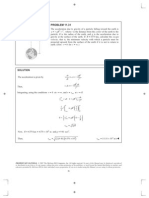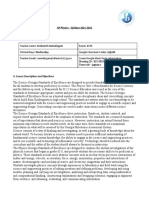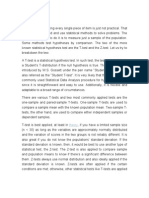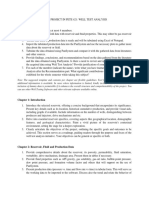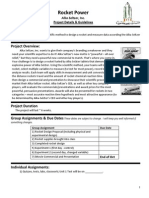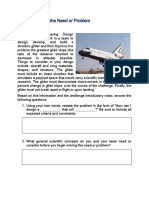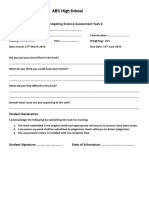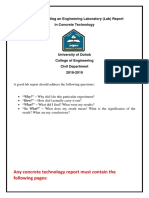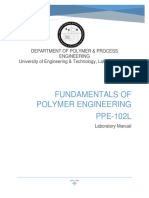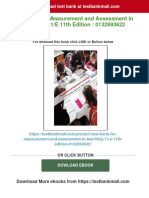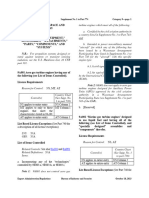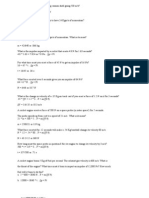2nd Term ADI
2nd Term ADI
Uploaded by
Iris BercesCopyright:
Available Formats
2nd Term ADI
2nd Term ADI
Uploaded by
Iris BercesOriginal Description:
Copyright
Available Formats
Share this document
Did you find this document useful?
Is this content inappropriate?
Copyright:
Available Formats
2nd Term ADI
2nd Term ADI
Uploaded by
Iris BercesCopyright:
Available Formats
Guide to the Water Bottle Rocket Competition
ARGUMENT DRIVEN INQUIRY
Figure 1. The stages of the ADI instructional model
STAGE 1
Identification of
the task and the
guiding question
STAGE 6
Write an
investigation
report
STAGE 7
Double-blind
group peer
review
STAGE 2
Design a method
and collect data
STAGE 5
Explicit and
reflective
discussion
STAGE 8
Revise and
submit report
STAGE 3
Analyze data and
develop a
tentative
argument
STAGE 4
Argumentation
session
GENERAL OBJECTIVES:
For this term, you are going to design, construct and launch your own water-propelled
bottle rocket. You are going to apply physics principles discussed in the previous term like
Newtons laws of motion and basic kinematics, along with new topics like projectile motion,
impulse and momentum, work-energy principle and fluid mechanics, to make the rocket meet a
set criteria. By the end of the term, your group is expected to construct a water bottle rocket
tailored for competition which would test for height efficiency, energy efficiency and accuracy.
This task will be performed step by step following the Argument Driven Inquiry (ADI) model
outlined in Figure 1.
LESSON 1 PROJECTILE MOTION
(Chapter 3 | pp. 38 58)
Stage 1 Identification of the Task
Objective:
Design and construct a bottle rocket that would launch with maximum efficiency.
Measures of Efficiency:
1. Maximum height; and
2. Initial velocity
Specific Objectives:
1. Compute for the maximum height reached by the bottle rocket; and
2. Compute for the bottle rockets initial speed and launch angle
Key Concepts:
Acceleration due to gravity, p. 41
Air resistance, p. 41
Free fall, p. 44
Trajectory, p. 48
Projectile motion, p. 49
At this stage, you must also start writing your Concept Map using the given key concepts
and other important terms introduced in the unit.
Stage 2 Methods for Data Collection
Procedure:
1. Write a methodology for gathering data to meet your Stage 1 objective. Make sure to
identify your variables and label them as dependent variables, independent variables or
controlled variables;
2. Secure the materials needed for data collection; and
3. Gather and record data.
Stage 3 Analysis of Data and Your Tentative Argument
Procedure:
1. Tabulate data;
2. Make preliminary computations; and
3. Decide if data gathered is enough to formulate a Valid Argument
If data is not enough, repeat Stage 2
Stage 4 Argumentation Session
Procedure:
Formulate an argument on your best practices or methods that worked for your group. Use the
worksheet: One Stay, Team Stray Argumentation Session as a guide in performing the activity.
Stage 5 Explicit and Reflective Discussion
Procedure:
Following the Argumentation Session, go back to your group and discuss how you can improve
your rocket design. Keep in mind the objective you need to meet in Stage 1. If you need to take
more measurements, you can repeat Stages 2 and 3.
Stage 6 Writing the Investigation Report
Procedure:
Using your revised methodology, data gathered and preliminary computations, start writing your
lab report following the IEEE format. The report may be formal or informal, as advised by the
teacher.
Stage 7 Double Blind Peer Review
Procedure:
Submit a copy of your lab report but DO NOT WRITE YOUR NAME. Instead, write a code name.
The lab reports will undergo a Double Blind Peer Review.
Mechanics:
The groups (if the report is informal) or students (if the report is formal) will review the reports of
other students. They must comment on the paper and write their comments using a colored pen.
They may use the document, Lab Report Rubrics - Checklist in reviewing the report. Sign your
name after reviewing the report.
Stage 8 Submission of Revised Report
Procedure:
Revise your lab report. Consider the comments written during the peer review. Submit the
revised lab report together with the draft.
END OF LESSON 1
Prepare for Summative Assessments. See Assessment Map for details.
Repeat ADI for the next lessons:
LESSON 2 IMPULSE AND MOMENTUM
(Chapter 7 | pp. 124 144)
Stage 1 Identification of the Task
Objective:
Design and construct a bottle rocket that would safely land following a successful launch.
Qualifiers for a Successful Launch:
1. Achieves optimum height; and
2. Launches at optimum initial velocity
Measure of Efficiency:
1. Egg secured inside the bottle rocket is intact (no visible crack) upon landing
Specific Objective:
1. Compute for the momentum of the bottle rocket at various points in its trajectory
Key Concepts:
Impulse, p. 126
Linear momentum, p.126
Impulse-momentum principle, p. 126
Conservation of momentum, p. 128
Recoil, p. 132
Perfectly inelastic collision, p. 133
Elastic collision, p. 133
Partially inelastic collision, p. 133
At this stage, you must also start writing your Concept Map using the given key concepts
and other important terms introduced in the unit.
LESSON 3 WORK, POWER AND ENERGY
(Chapter 6 | pp. 102 - 123)
Stage 1 Identification of the Task
Objective:
Design and construct a bottle rocket that would launch at maximum power.
Measures of Efficiency:
1. Maximum height; and
2. Least amount of time spent pumping
Specific Objectives:
1. Compute for the bottle rockets maximum gravitational potential energy and kinetic
energy; and
2. Compute for the power dissipated in launching the bottle rocket.
Key Concepts:
Work, p. 104
Power, p. 106
Kinetic energy, p. 106
Negative work, p. 107
Potential energy, p. 108
Gravitational potential energy, p. 108
Conservation of energy, p. 109
Conservative forces, p. 110
At this stage, you must also start writing your Concept Map using the given key concepts
and other important terms introduced in the unit.
LESSON 4 FLUID PRESSURE
(Chapter 9 | pp. 170 - 191)
Stage 1 Identification of the Task
Objective:
Design and construct a bottle rocket that would launch with maximum efficiency.
Measures of Efficiency:
1. Maximum height; and
2. Aerodynamics
Specific Objectives:
1. Examine the role of fluid pressure inside the bottle rocket in its launch; and
2. Examine the role of fluid flow outside the bottle rocket in keeping it stable.
Key Concepts:
Pressure, p. 171
Pascals principle, p. 172
Viscosity, p. 182
Turbulent flow, p. 183
Bernoullis principle, p. 185
At this stage, you must also start writing your Concept Map using the given key concepts
and other important terms introduced in the unit.
CHECKLIST OF WHAT YOU NEED TO ACCOMPLISH THIS TERM:
ACTIVITY
Accomplished
Yes/No?
Remarks
Bottle Rocket 1 Projectile Motion
Argument Driven Inquiry
Stage
Stage
Stage
Stage
1
2
3
4
Stage
Stage
Stage
Stage
5
6
7
8
Stage
Stage
Stage
Stage
1
2
3
4
Stage
Stage
Stage
Stage
5
6
7
8
Stage
Stage
Stage
Stage
1
2
3
4
Stage
Stage
Stage
Stage
5
6
7
8
Stage
Stage
Stage
Stage
1
2
3
4
Stage
Stage
Stage
Stage
5
6
7
8
Concept Map
Lab Report
Unit Test
Bottle Rocket 2 Impulse & Momentum
Argument Driven Inquiry
Concept Map
Lab Report
Unit Test
Bottle Rocket 3 Work, Power & Energy
Argument Driven Inquiry
Concept Map
Lab Report
Unit Test
Bottle Rocket 4 Fluid Pressure
Argument Driven Inquiry
Concept Map
Performance Task: Water Bottle Rocket
Competition
First to Launch
Longest hang time
Accuracy
You might also like
- Hot Wheels Physics PacketDocument64 pagesHot Wheels Physics PacketMrCiambrone83% (6)
- of How Children Develop 6th Edition Edition PDFDocument1 pageof How Children Develop 6th Edition Edition PDFzahramohamed9991No ratings yet
- Open Records Violations (Redacted)Document251 pagesOpen Records Violations (Redacted)Jack ChilesNo ratings yet
- Science MasterkeyDocument287 pagesScience MasterkeyDinesh90% (10)
- CDC Statement On ReanalysisDocument1 pageCDC Statement On Reanalysisslupkin923No ratings yet
- Chp11 p36 52Document17 pagesChp11 p36 52Muhammad Izzat100% (1)
- Active Learning Strategies in PhysicsDocument22 pagesActive Learning Strategies in Physicsapi-529106856No ratings yet
- Compendium NotebookDocument22 pagesCompendium Notebookapi-276681360No ratings yet
- Scientificmethod (Blackbox) LabDocument4 pagesScientificmethod (Blackbox) LabtommkoNo ratings yet
- Who Is Writing Maine's Laws?Document26 pagesWho Is Writing Maine's Laws?MainesMajority100% (1)
- AP Environmental Science Lab Soil Microbial Activity and Soil Organic Matter TeDocument18 pagesAP Environmental Science Lab Soil Microbial Activity and Soil Organic Matter TesardinhaeloisaNo ratings yet
- 2008 - Jaffe DVDocument18 pages2008 - Jaffe DVValerie R. HoughtonNo ratings yet
- 1a Ap Physics Syllabus - 2021-2022Document5 pages1a Ap Physics Syllabus - 2021-2022api-269229107No ratings yet
- AP Physics B Free Response IndexDocument7 pagesAP Physics B Free Response Indexandrew4mail94No ratings yet
- Feb. 14 2022 GFPS Biermaier AD HireDocument6 pagesFeb. 14 2022 GFPS Biermaier AD HireJoe BowenNo ratings yet
- OPEGA Report: How DHHS Dealt With Child Abuse Death CasesDocument9 pagesOPEGA Report: How DHHS Dealt With Child Abuse Death CasesNEWS CENTER MaineNo ratings yet
- Psychological TestingDocument40 pagesPsychological TestingNida Soriano BallesterosNo ratings yet
- Ending Critical Race Theory in D.C. Public Schools ActDocument4 pagesEnding Critical Race Theory in D.C. Public Schools ActThe FederalistNo ratings yet
- Introduction To Child ForensicDocument7 pagesIntroduction To Child ForensicTefera TekleNo ratings yet
- Psyc. 2301 Signature Assignment-Serial Killers Nature vs. NurtureDocument6 pagesPsyc. 2301 Signature Assignment-Serial Killers Nature vs. NurtureGabe OrnesNo ratings yet
- Subtest OriginsDocument38 pagesSubtest OriginsCharlie HultgreenNo ratings yet
- Child Protection Assessment ChecklistDocument7 pagesChild Protection Assessment ChecklistJohn Mark Alpos100% (1)
- PanSystem Final Requirement General Instruction and TemplateDocument2 pagesPanSystem Final Requirement General Instruction and TemplateJoann MabilingNo ratings yet
- Grade 8 - Criteria B and C Factors Affecting Rocket Performance AssessmentDocument8 pagesGrade 8 - Criteria B and C Factors Affecting Rocket Performance Assessmentapi-291745547No ratings yet
- Year 12 OpenDocument17 pagesYear 12 OpenElvis WayneNo ratings yet
- Advanced Higher Physics Investigation GuidanceDocument9 pagesAdvanced Higher Physics Investigation Guidance10toluwanidNo ratings yet
- If You Finish Early, You May Begin The Process of Proof-Reading Your Lab Reports. I Did Not Go Over Your Submissions With A Fine-Toothed CombDocument14 pagesIf You Finish Early, You May Begin The Process of Proof-Reading Your Lab Reports. I Did Not Go Over Your Submissions With A Fine-Toothed CombMr. CNo ratings yet
- Winter Term Syllabus Jan-2023Document30 pagesWinter Term Syllabus Jan-2023Rajesh GovindanNo ratings yet
- Aerospace Engineering Lab 1 DocumentDocument61 pagesAerospace Engineering Lab 1 DocumentMai Nguyễn Minh NhậtNo ratings yet
- Screenshot 2024-03-25 at 8.22.06 AMDocument70 pagesScreenshot 2024-03-25 at 8.22.06 AMLayan AlqudrahNo ratings yet
- Laboratory Report Guidelines JKUAT UndergraduateDocument3 pagesLaboratory Report Guidelines JKUAT UndergraduateDECENT DECENT MUSINAINo ratings yet
- Engineeringprocessspace SunminyeoDocument3 pagesEngineeringprocessspace Sunminyeoapi-297734344No ratings yet
- CH228 Lab Manual S24Document56 pagesCH228 Lab Manual S24miganiNo ratings yet
- Project Overview - 6thDocument4 pagesProject Overview - 6thapi-219812589No ratings yet
- Problem-Based Learning (PBL) ActivitiesDocument9 pagesProblem-Based Learning (PBL) ActivitiesUmarJuttNo ratings yet
- https___d2bv2xoq3lkf8w.cloudfront.net_nlms-cdn-mec_nlms_content_1729523885_CIVL 0018.1_ Fall 24 (1)Document12 pageshttps___d2bv2xoq3lkf8w.cloudfront.net_nlms-cdn-mec_nlms_content_1729523885_CIVL 0018.1_ Fall 24 (1)Younas DawarNo ratings yet
- SESSION 2 D CONTENT 6Document31 pagesSESSION 2 D CONTENT 6Karine H. LansangNo ratings yet
- Report ManagementDocument1 pageReport ManagementSBONGISENI MASONDONo ratings yet
- Group 5 - Value Engineering Use CaseDocument25 pagesGroup 5 - Value Engineering Use CaseParesh SwamiNo ratings yet
- Open Channel Flow Lap ExperimentDocument4 pagesOpen Channel Flow Lap ExperimentgouravNo ratings yet
- Mod 2 Act 3 RMPDocument2 pagesMod 2 Act 3 RMPDiegoto IvaNo ratings yet
- MVS Workbook No 2Document103 pagesMVS Workbook No 2Stephen Sogah100% (1)
- EDP ProjectDocument13 pagesEDP ProjectNIÑA BELENNo ratings yet
- Lab Guidelines and EvalautionDocument3 pagesLab Guidelines and EvalautionRajath ShettyNo ratings yet
- Year 10 Chemistry Investigation Take Home 2023 - Anne SersDocument12 pagesYear 10 Chemistry Investigation Take Home 2023 - Anne Serskeira.goorayahNo ratings yet
- Improvement Activity DataDocument2 pagesImprovement Activity Dataisabella castaNo ratings yet
- Practical HandbookDocument9 pagesPractical Handbookdiane hoylesNo ratings yet
- Mec 204Document36 pagesMec 204mhe406317No ratings yet
- AE3211 Space Group Tutorial Assignment 2024Document4 pagesAE3211 Space Group Tutorial Assignment 2024umarh1.uhNo ratings yet
- EE416_classroom-activity-4Document3 pagesEE416_classroom-activity-4johnpaulshobayanNo ratings yet
- 2b Ass 2Document15 pages2b Ass 2api-518845431No ratings yet
- FEM Lab Course HandoutDocument2 pagesFEM Lab Course HandoutmzaidpervezNo ratings yet
- EMSPL3A 2024 GA11 GuidelinesDocument5 pagesEMSPL3A 2024 GA11 GuidelinesMOJALEFA JACOB MOLEFINo ratings yet
- Model HelicopterDocument2 pagesModel HelicopterAnan BarghouthyNo ratings yet
- Activity Guide and Evaluation Rubric - Step 0 - Recognize Technologic Innovation As A Key Source For Successful BusinessDocument14 pagesActivity Guide and Evaluation Rubric - Step 0 - Recognize Technologic Innovation As A Key Source For Successful Businessmery sanchezNo ratings yet
- OCT 2022 valueengineering-UNITDocument36 pagesOCT 2022 valueengineering-UNITsyed wahid aliNo ratings yet
- Any Concrete Technology Report Must Contain The Following PagesDocument11 pagesAny Concrete Technology Report Must Contain The Following PagesYoukhanna ZayiaNo ratings yet
- FPE Lab Manual Introduction PDFDocument45 pagesFPE Lab Manual Introduction PDFFARANNo ratings yet
- CENG 3264: Engin Des and Project MGMT - Lab 1 Microsoft Project TutorialDocument7 pagesCENG 3264: Engin Des and Project MGMT - Lab 1 Microsoft Project Tutorialgopika hariNo ratings yet
- Valueengineering 141206000637 Conversion Gate02 PDFDocument36 pagesValueengineering 141206000637 Conversion Gate02 PDFRachanesh GhatgeNo ratings yet
- E-Content (Q) Programme: Laboratory and Workshop Management (Module III) Performance Assessment in Laboratory and WorkshopDocument7 pagesE-Content (Q) Programme: Laboratory and Workshop Management (Module III) Performance Assessment in Laboratory and WorkshoppriyaNo ratings yet
- (PDF Download) Test Bank For Measurement and Assessment in Teaching, 11/E 11th Edition: 0132893622 Fulll ChapterDocument50 pages(PDF Download) Test Bank For Measurement and Assessment in Teaching, 11/E 11th Edition: 0132893622 Fulll Chapternicegrudaj100% (5)
- Saturn V S-IC Rocket EnginesDocument48 pagesSaturn V S-IC Rocket EnginesAviation/Space History Library100% (1)
- Physics Project (Final)Document17 pagesPhysics Project (Final)Namrata Agarwal0% (1)
- Multiple Choice: Identify The Choice That Best Completes The Statement or Answers The QuestionDocument8 pagesMultiple Choice: Identify The Choice That Best Completes The Statement or Answers The QuestionMona Mohamed SafwatNo ratings yet
- Resume OnlineDocument2 pagesResume Onlineapi-265095092No ratings yet
- Makeshift Arsenal by LoweryDocument37 pagesMakeshift Arsenal by LoweryD50% (2)
- Shuttle Performance Lessons Learned, Part 2Document760 pagesShuttle Performance Lessons Learned, Part 2Bob Andrepont100% (1)
- Rocket PropulsionDocument29 pagesRocket Propulsiondhinadiwa100% (1)
- Phyf4 Chap2Document179 pagesPhyf4 Chap2Mohd AzlanNo ratings yet
- Design and Analysis of Vented Interstage in A Typical Launch Vehicle IJERTV4IS080369Document5 pagesDesign and Analysis of Vented Interstage in A Typical Launch Vehicle IJERTV4IS080369Jav butNo ratings yet
- Mastering Physics CH 09 HW College Physics I LCCCDocument19 pagesMastering Physics CH 09 HW College Physics I LCCCSamuel100% (3)
- Basics of Space Flight - Rocket PropulsionDocument20 pagesBasics of Space Flight - Rocket PropulsionAIEIMANo ratings yet
- Practice Problems in Newton's LawsDocument21 pagesPractice Problems in Newton's LawsBrianca F BarzaNo ratings yet
- Stage SeparationDocument29 pagesStage SeparationShekar Gundavarapu100% (4)
- Nr420301 Jet Propulsion and Rocket EngineeringDocument2 pagesNr420301 Jet Propulsion and Rocket Engineeringgeddam06108825No ratings yet
- CCL9Document66 pagesCCL91309876204No ratings yet
- Notes 3654 6642 2ndtermgrade7revisionmaterialsolvedDocument30 pagesNotes 3654 6642 2ndtermgrade7revisionmaterialsolvedjeremy millerNo ratings yet
- Topic-1C - 3 Conservation of Momentum: Ten of The Following Problems: andDocument11 pagesTopic-1C - 3 Conservation of Momentum: Ten of The Following Problems: andQuiz LetNo ratings yet
- Starsmith Assets Mar 5 23Document71 pagesStarsmith Assets Mar 5 23BenNo ratings yet
- As 21c Motion&ForceDocument40 pagesAs 21c Motion&ForceHany ElGezawyNo ratings yet
- What Is The Momentum of A 23 KG Cannon Shell Going 530 MDocument13 pagesWhat Is The Momentum of A 23 KG Cannon Shell Going 530 MJill EneroNo ratings yet
- El Problema Del Viaje Espacial - Herman PotoskyDocument168 pagesEl Problema Del Viaje Espacial - Herman PotoskySam VimesNo ratings yet
- SyllabusDocument3 pagesSyllabusAasto Ashrita AastikaeNo ratings yet
- Rectilinear Motion, Motion Graphs, Projectile and Curvilinear Motion, and Tangential and Normal Motion Sample ProblemsDocument16 pagesRectilinear Motion, Motion Graphs, Projectile and Curvilinear Motion, and Tangential and Normal Motion Sample ProblemsJohn AngeloNo ratings yet
- Process of Launching Space Vehicles and SatellitesDocument25 pagesProcess of Launching Space Vehicles and SatellitesAnilkumar s KenchanagoudrNo ratings yet
- Time Magazine Falls For Rocket Launch HoaxDocument1 pageTime Magazine Falls For Rocket Launch HoaxSpace Frontier Foundation100% (3)
- History of Space Flight PDFDocument9 pagesHistory of Space Flight PDFErie FujitaNo ratings yet
- Hybrid RocketDocument6 pagesHybrid RocketAnonymous 0ZP9AmIENo ratings yet
- Liquid Rocket EnginesDocument28 pagesLiquid Rocket Enginesnab05No ratings yet





